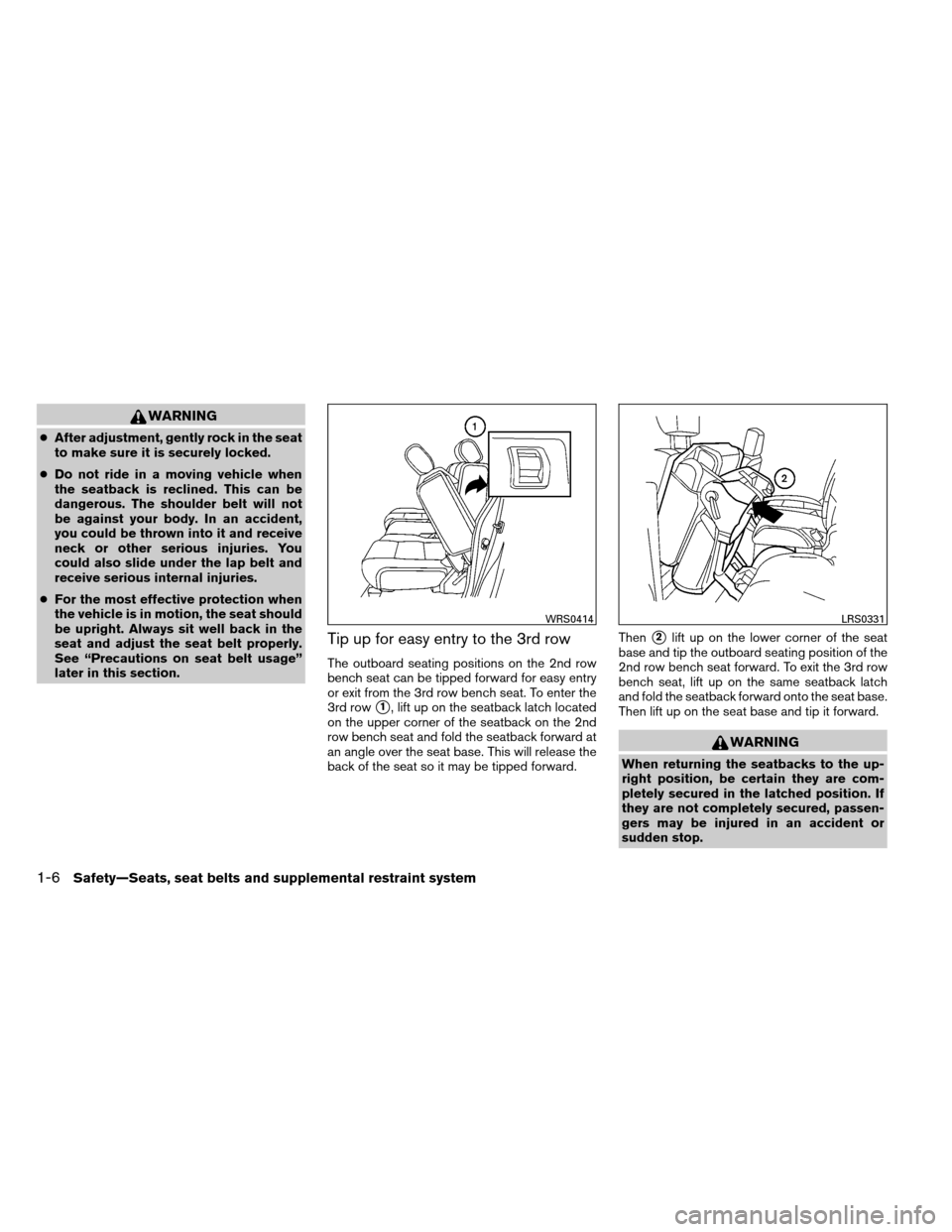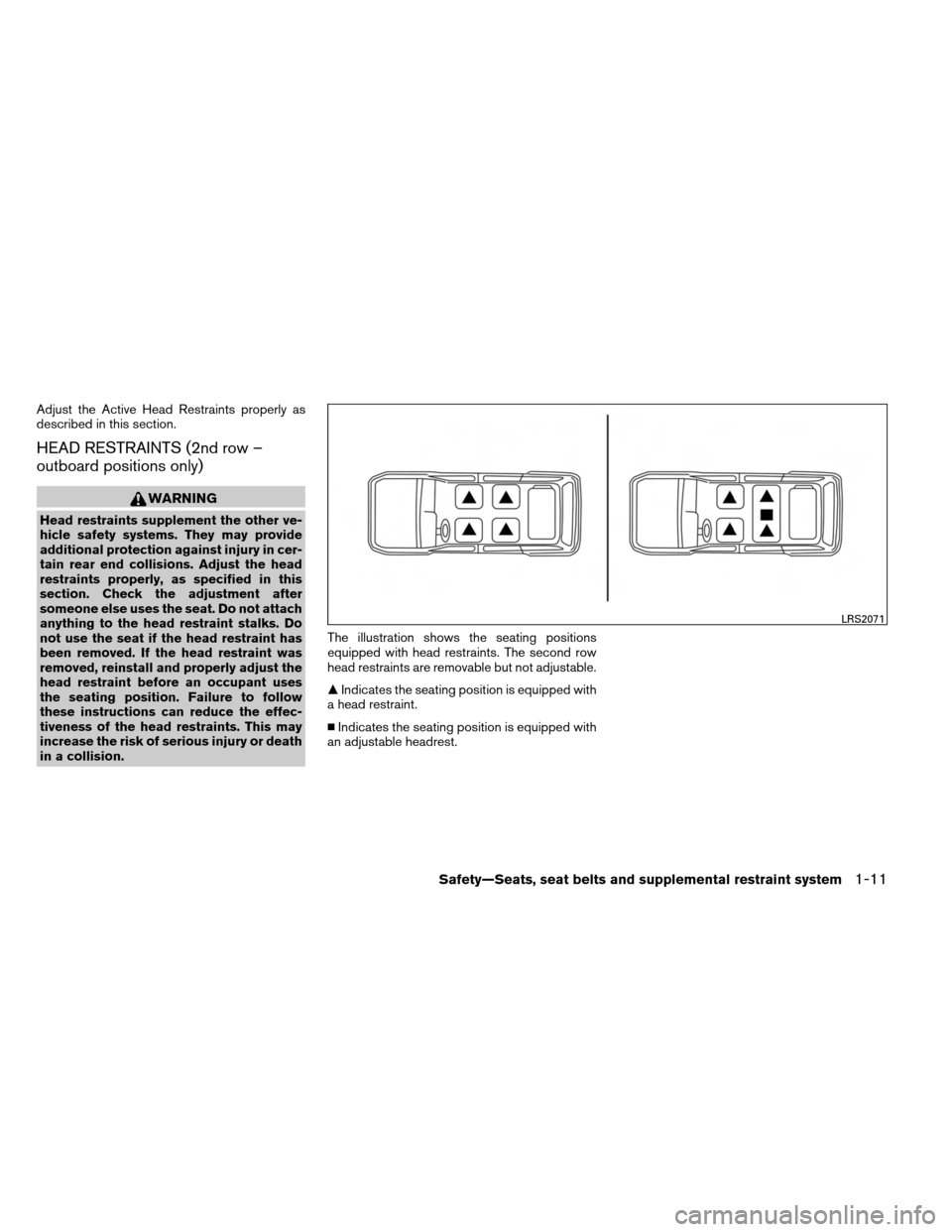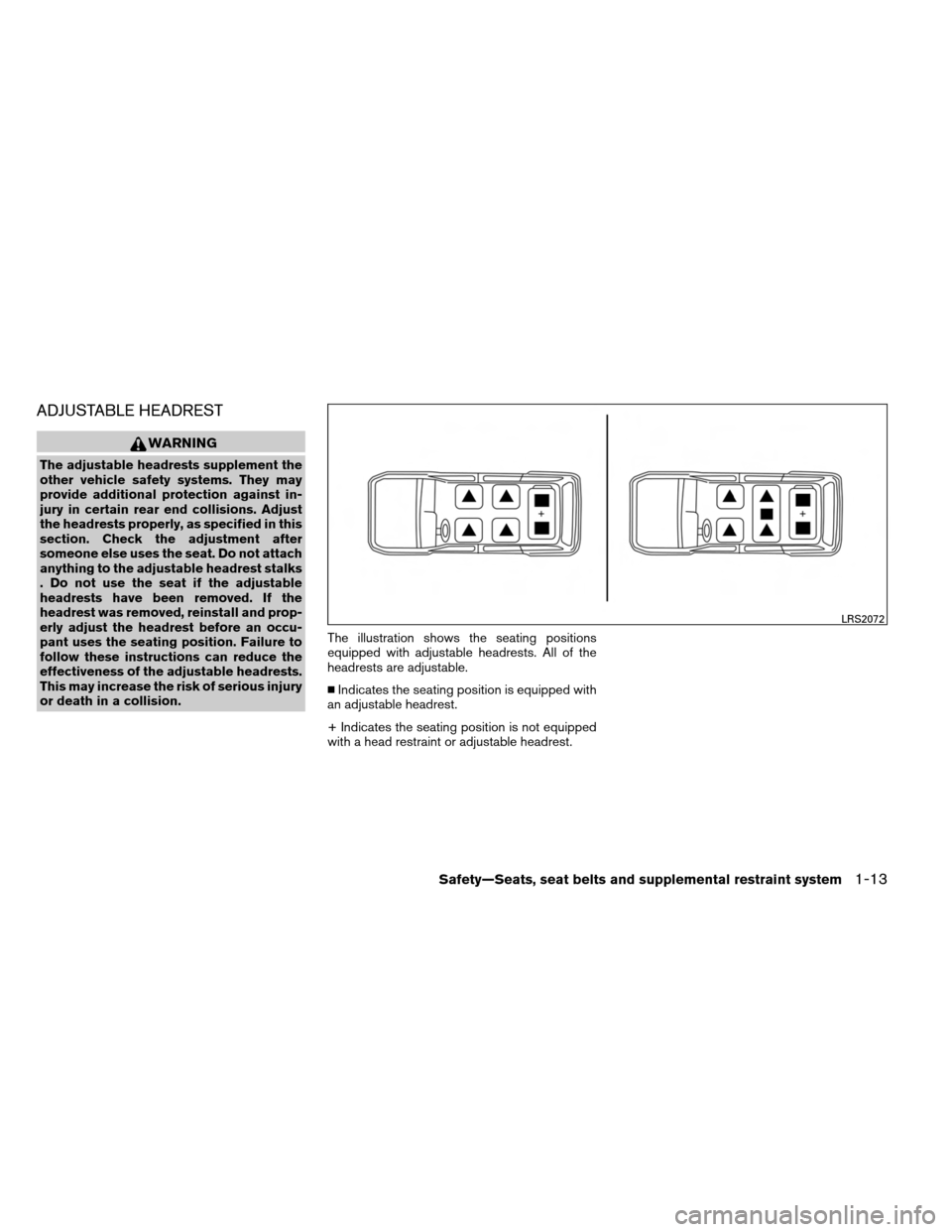Page 23 of 489

WARNING
●After adjustment, gently rock in the seat
to make sure it is securely locked.
● Do not ride in a moving vehicle when
the seatback is reclined. This can be
dangerous. The shoulder belt will not
be against your body. In an accident,
you could be thrown into it and receive
neck or other serious injuries. You
could also slide under the lap belt and
receive serious internal injuries.
● For the most effective protection when
the vehicle is in motion, the seat should
be upright. Always sit well back in the
seat and adjust the seat belt properly.
See “Precautions on seat belt usage”
later in this section.
Tip up for easy entry to the 3rd row
The outboard seating positions on the 2nd row
bench seat can be tipped forward for easy entry
or exit from the 3rd row bench seat. To enter the
3rd row
�1, lift up on the seatback latch located
on the upper corner of the seatback on the 2nd
row bench seat and fold the seatback forward at
an angle over the seat base. This will release the
back of the seat so it may be tipped forward. Then
�2lift up on the lower corner of the seat
base and tip the outboard seating position of the
2nd row bench seat forward. To exit the 3rd row
bench seat, lift up on the same seatback latch
and fold the seatback forward onto the seat base.
Then lift up on the seat base and tip it forward.
WARNING
When returning the seatbacks to the up-
right position, be certain they are com-
pletely secured in the latched position. If
they are not completely secured, passen-
gers may be injured in an accident or
sudden stop.
WRS0414LRS0331
1-6Safety—Seats, seat belts and supplemental restraint system
Page 24 of 489
ARMRESTS
To use the armrests, pull them down to the rest-
ing position.
�AStowed position
�BResting position
HEAD RESTRAINTS (1st row only)
WARNING
Head restraints supplement the other ve-
hicle safety systems. They may provide
additional protection against injury in cer-
tain rear end collisions. Adjust the head
restraints properly, as specified in this
section. Check the adjustment after
someone else uses the seat. Do not attach
anything to the head restraint stalks. Do
not use the seat if the head restraint has
been removed. If the head restraint was
removed, reinstall and properly adjust the
head restraint before an occupant uses
the seating position. Failure to follow
these instructions can reduce the effec-
tiveness of the head restraints. This may
increase the risk of serious injury or death
in a collision.
WRS0368
Safety—Seats, seat belts and supplemental restraint system1-7
Page 25 of 489
The illustration shows the seating positions
equipped with head restraints. The first row head
restraints are adjustable.
�Indicates the seating position is equipped with
a head restraint.
� Indicates the seating position is equipped with
an adjustable headrest.Components
1. Head restraint
2. Adjustment notches
3. Lock knob
4. Stalks
LRS2071LRS0887
1-8Safety—Seats, seat belts and supplemental restraint system
Page 26 of 489
Adjustment
Adjust the head restraint so the center is level
with the center of the seat occupant’s ears.To raise the head restraint, pull it up.
To lower, push and hold the lock knob and push
the head restraint down.
WRS0134LRS0888LRS0889
Safety—Seats, seat belts and supplemental restraint system1-9
Page 27 of 489

Removal
Use the following procedure to remove the ad-
justable head restraints.1. Pull the head restraint up to the highest position.
2. Push and hold the lock knob.
3. Remove the head restraint from the seat.
4. Store the head restraint properly so it is not loose in the vehicle.
5. Reinstall and properly adjust the head re- straint before an occupant uses the seating
position.
Install
1. Align the head restraint stalks with the holesin the seat. Make sure the head restraint is
facing the correct direction. The stalk with
the adjustment notches
�1must be installed
in the hole with the lock knob
�2.
2. Push and hold the lock knob and push the head restraint down.
3. Properly adjust the head restraint before an occupant uses the seating position.
Front-seat Active Head Restraints
The Active Head Restraint moves forward utiliz-
ing the force that the seatback receives from the
occupant in a rear-end collision. The movement
of the head restraint helps support the occu-
pant’s head by reducing its backward movement
and helping absorb some of the forces that may
lead to whiplash-type injuries.
Active Head Restraints are effective for collisions
at low to medium speeds in which it is said that
whiplash injury occurs most.
Active Head Restraints operate only in certain
rear-end collisions. After the collision, the head
restraints return to their original position.
LRS0890LRS0891SPA1025
1-10Safety—Seats, seat belts and supplemental restraint system
Page 28 of 489

Adjust the Active Head Restraints properly as
described in this section.
HEAD RESTRAINTS (2nd row –
outboard positions only)
WARNING
Head restraints supplement the other ve-
hicle safety systems. They may provide
additional protection against injury in cer-
tain rear end collisions. Adjust the head
restraints properly, as specified in this
section. Check the adjustment after
someone else uses the seat. Do not attach
anything to the head restraint stalks. Do
not use the seat if the head restraint has
been removed. If the head restraint was
removed, reinstall and properly adjust the
head restraint before an occupant uses
the seating position. Failure to follow
these instructions can reduce the effec-
tiveness of the head restraints. This may
increase the risk of serious injury or death
in a collision.The illustration shows the seating positions
equipped with head restraints. The second row
head restraints are removable but not adjustable.
�
Indicates the seating position is equipped with
a head restraint.
� Indicates the seating position is equipped with
an adjustable headrest.
LRS2071
Safety—Seats, seat belts and supplemental restraint system1-11
Page 29 of 489
Components
1. Head restraint
2. Lock knob
3. Stalks
Removal
Use the following procedure to remove the head
restraints.1. Adjust the seat or seatback as necessary.
2. Push and hold the lock knob(s) .
3. Pull the head restraint up until it is removed from the seat.
4. Store the head restraint properly so it is not loose in the vehicle.
5. Reinstall the head restraint and properly ad- just the seat or seatback before an occupant
uses the seating position.
Install
1. Align the head restraint stalks with the holes
in the seat. Make sure the head restraint is
facing the correct direction.
2. Push the head restraint down until it locks in place.
LRS2073LRS2074LRS2075
1-12Safety—Seats, seat belts and supplemental restraint system
Page 30 of 489

ADJUSTABLE HEADREST
WARNING
The adjustable headrests supplement the
other vehicle safety systems. They may
provide additional protection against in-
jury in certain rear end collisions. Adjust
the headrests properly, as specified in this
section. Check the adjustment after
someone else uses the seat. Do not attach
anything to the adjustable headrest stalks
. Do not use the seat if the adjustable
headrests have been removed. If the
headrest was removed, reinstall and prop-
erly adjust the headrest before an occu-
pant uses the seating position. Failure to
follow these instructions can reduce the
effectiveness of the adjustable headrests.
This may increase the risk of serious injury
or death in a collision.The illustration shows the seating positions
equipped with adjustable headrests. All of the
headrests are adjustable.
�
Indicates the seating position is equipped with
an adjustable headrest.
+ Indicates the seating position is not equipped
with a head restraint or adjustable headrest.
LRS2072
Safety—Seats, seat belts and supplemental restraint system1-13